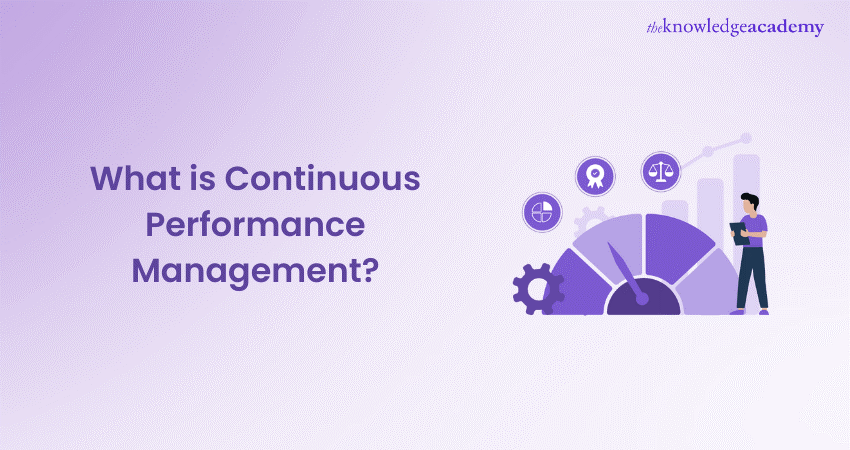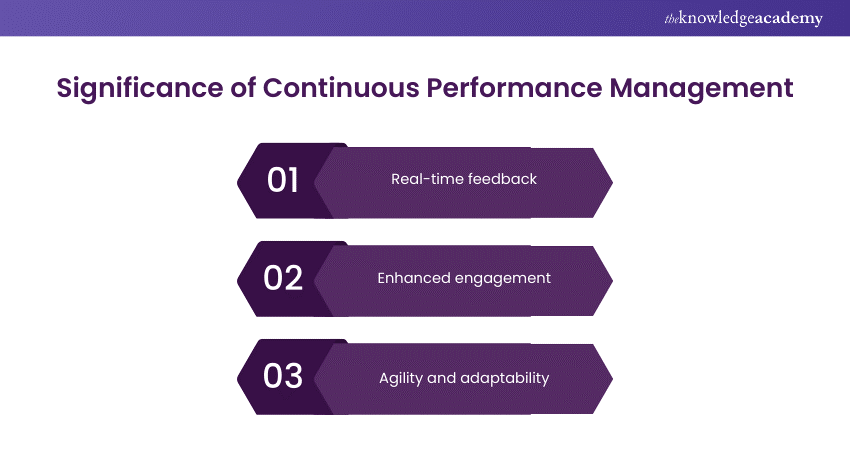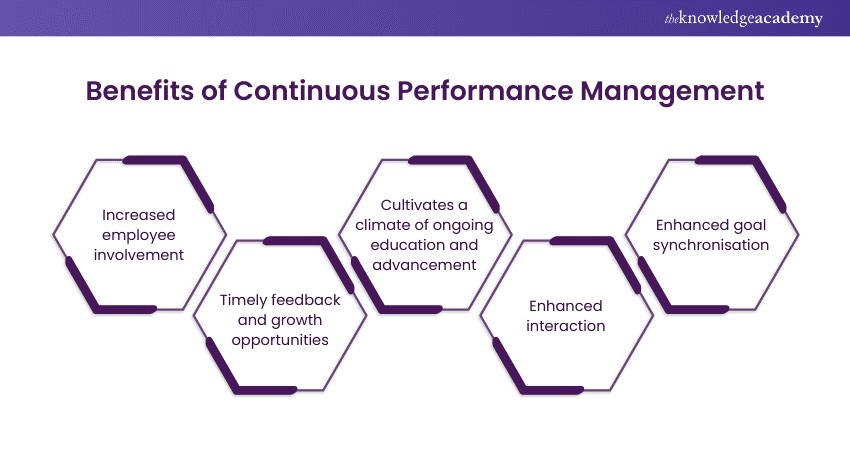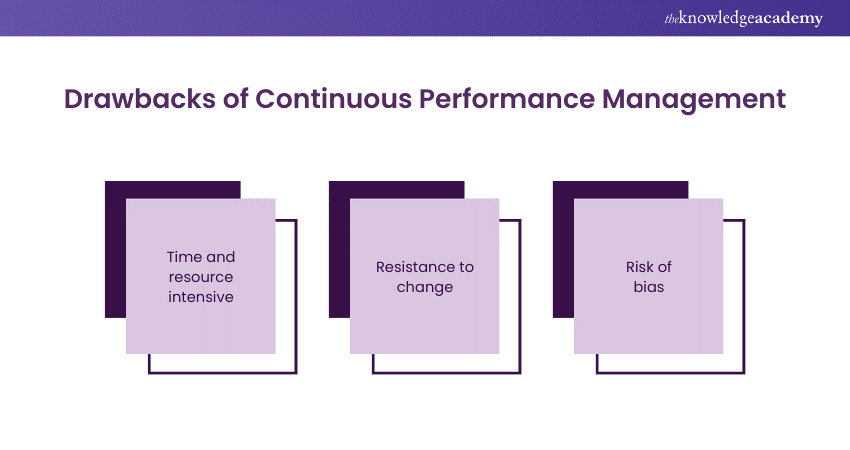We may not have the course you’re looking for. If you enquire or give us a call on +46 850282424 and speak to our training experts, we may still be able to help with your training requirements.
Training Outcomes Within Your Budget!
We ensure quality, budget-alignment, and timely delivery by our expert instructors.

In today's dynamic work environment, traditional annual performance reviews are gradually becoming obsolete. Enter Continuous Performance Management (CPM), a progressive approach aimed at enhancing employee engagement, productivity, and growth. In this blog, we'll delve into the depths of CPM, exploring its significance, benefits, implementation strategies, best practices, software solutions, and potential drawbacks.
Table of Contents
1) What is Continuous Performance Management?
2) Significance of Continuous Performance Management
3) Who embraces Continuous Performance Management?
4) What are the benefits of Continuous Performance Management?
5) How to integrate Continuous Performance Management into Your Company
6) Optimal Practices for Continuous Performance Management
7) What function does Continuous Performance Management Software serve?
8) Drawbacks of Continuous Performance Management
9) Conclusion
What Is Continuous Performance Management?
Continuous Performance Management is a modern approach to managing employee performance that emphasises ongoing feedback, coaching, and development rather than annual or periodic reviews. It involves regular check-ins between managers and employees to discuss goals, progress, challenges, and developmental needs. Continuous Performance Management creates a dynamic feedback loop that enables employees to receive timely guidance and support, leading to continuous improvement and growth.
Significance of Continuous Performance Management

The significance of CONTINUOUS lies in its ability to adapt to the rapidly changing nature of work and employee expectations. By fostering regular communication and feedback, it promotes a culture of transparency, accountability, and collaboration within organisations. Additionally, Continuous Project Management helps align individual goals with organisational objectives, driving performance and productivity across all levels.
The significance of Continuous Performance Management lies in:
1) Real-time feedback: It enables continuous feedback loops, allowing for timely course corrections and performance improvements.
2) Enhanced engagement: By fostering regular communication and goal alignment, it boosts employee engagement and motivation.
3) Agility and adaptability: Continuous Project management promotes a culture of learning and development, empowering organisations to stay agile and responsive to change.
Who Embraces Continuous Performance Management?
Organisations across various industries are embracing Continuous Performance Management as they recognise its potential to enhance employee engagement, satisfaction, and retention. From startups to Fortune 500 companies, Continuous Project Management is gaining traction among forward-thinking leaders who prioritise employee development and organisational agility.
Improve your organisational efficiency through our Introduction to Performance Management Course.
What are the benefits of Continuous Performance Management?
Continuous Performance Management offers several significant benefits to organisations. Firstly, it enhances employee engagement by providing regular feedback, which fosters a sense of involvement and ownership among employees. This heightened engagement translates into improved performance as employees receive timely guidance and support, enabling them to address challenges promptly and capitalise on growth opportunities.
Moreover, CPM fosters an environment of perpetual learning and growth, enabling staff to consistently improve their competencies. These advantages bolster manager-employee rapport, elevate productivity, and harmonise with company objectives. Let's look at some of the benefits of Continuous Performance Management:

1) Increased employee involvement
Workers being taken onboard is one of the main benefits of CPM that promote the spirit of belonging and loyalty in employees towards their workplace and the company. The staff representatives are involved in every step from setting the goals, monitoring attainment, and coming up with suggestions for development by using the feedback loops and open communication channels which are facilitated by Continuous Project Management regularly. This increased involvement empowers employees to take charge of their own development and performance, leading to a greater sense of accountability for their actions and outcomes.
Moreover, when employees feel that their opinions and contributions are valued, they become more engaged in their work and feel a stronger connection to the organisation's mission and goals. Through this Continuous Project Management many workers end up being able to discuss their problems, express their creative thoughts, and work together with their seniors and other colleagues to resolve issues and attain the goals set. This environment, which enables employees to work together, not only brings employees' morale and exposure to work-related issues but also contributes to the development of camaraderie and teamwork in the workplace.
2) Timely feedback and growth opportunities
Timely feedback and growth opportunities are pivotal components of Continuous Performance Management (CPM), offering employees a pathway for continual improvement and development within their roles. In the framework of Continuous Project Management, feedback is not confined to annual or sporadic evaluations but rather becomes an ongoing dialogue between managers and employees, enabling them to address strengths, areas for improvement, and future goals in a timely manner.
A crucial feature of real-time feedback is its effective role in quick term adjustment to the wrong direction. We now conduct regular performance appraisals, so employees can take immediate corrective action and improve on relevant areas. In this kind of framework, not only productivity is increased but also small problems have no chance of transforming into larger concerns which leads to efficiency and effectiveness of the outputs.
3) Cultivates a climate of ongoing education and advancement
Continuous Performance Management (CPM) fosters a climate of ongoing education and advancement within organisations, creating an environment where learning is not just an occasional activity but a continuous journey of growth and development. This aspect of CPM is crucial in today's fast-paced business landscape, where adaptability and continuous learning are essential for both individual and organisational success.
Among the most critical contributions Continuous Project Management makes to this atmosphere is it tends to promote regular conversations and feedback between the managers and the employees. By holding regular meetings and performance reviews, employees are able to get important feedback on their best practices as well as areas for being challenged as well as possible growth opportunities. This is an ongoing feedback loop which plays as a key igniter for learning, therefore employees try to seek different resources, trainings and developmental opportunities so that they can improve and increase their skills and abilities.
4) Enhanced interaction
Enhanced interaction is a fundamental aspect of Continuous Performance Management (CPM) that fosters stronger relationships and communication between managers and employees. Unlike traditional performance management approaches that rely on infrequent evaluations, CPM encourages regular and meaningful interactions that facilitate collaboration, feedback, and alignment of goals.
One of the main ways CPM enhances interaction is through frequent check-ins and feedback sessions between managers and employees. These sessions provide opportunities for open dialogue, where employees can discuss their progress, challenges, and goals with their managers in a supportive and constructive environment. By promoting regular communication, Continuous Project Management helps to build trust, transparency, and rapport between managers and employees, laying the foundation for a positive and productive working relationship.
5) Enhanced goal synchronisation
Goal alignment is one of the vital elements of Continuous Performance Management (CPM) which is meant to make sure that the organisational goals and the goals of individuals complement each other. Through the establishment of clear targets and objectives and the short-term milestones, CPM helps employees realise how their work plays a part in achieving the bigger mission and goals of the organisation.
One of the main ways CPM enhances goal synchronisation is through the establishment of clear and transparent objectives. Rather than relying on vague or ambiguous goals, Continuous Project Management encourages managers and employees to collaborate in setting SMART (Specific, Measurable, Achievable, Relevant, Time-bound) goals that are aligned with organisational priorities and strategic initiatives. This clarity and specificity enable employees to understand the expectations for their performance and how their efforts contribute to the achievement of broader organisational objectives.
How to integrate Continuous Performance Management into your company?
Integrating Continuous Performance Management into your company requires a strategic approach that involves aligning processes, systems, and culture with the principles of Continuous Project Management. Key steps include:
1) Establish Clear Expectations: Clearly communicate the purpose and benefits of CPM to employees and managers.
2) Provide Training and Support: Offer training and resources to help managers and employees embrace the principles of CPM and develop the necessary skills.
3) Implement Technology Solutions: Invest in performance management software that facilitates regular check-ins, feedback, and goal tracking.
4) Monitor and Adapt: Regularly assess the efficacy of CPM procedures and modify them accordingly to enhance performance and employee contentment.
Optimal practices for Continuous Performance Management
To ensure the success of Continuous Performance Management initiatives, organisations should adopt the following best practices:
1) Consistent and frequent meetings
Promote managers to engage in frequent meetings with employees to review progress, offer feedback, and tackle any issues or obstacles they encounter.
2) Establish transparent objectives
Set clear and measurable goals that align with organisational priorities and provide employees with visibility into how their work contributes to broader objectives.
3) Foster psychological comfort
Establish an environment that fosters support and inclusivity, encouraging employees to freely provide feedback, openly discuss challenges, and seek assistance as needed.
4) Offer managerial and employee training
Provide training and development opportunities for both managers and employees to enhance their communication, coaching, and performance management skills.
What function does Continuous Performance Management Software serve?
Continuous Performance Management software simplifies the performance evaluation process through features facilitating goal establishment, feedback gathering, performance monitoring, and data analysis. These platforms enable organisations to automate administrative tasks, facilitate communication between managers and employees, and gain insights into employee performance and engagement.
Drawbacks of Continuous Performance Management
While Continuous Performance Management offers numerous benefits, its drawbacks, are:

1) Time and resource intensive: Implementing and maintaining Continuous Project Management practices requires significant time and resources, especially in larger organisations.
2) Resistance to change: Some employees and managers may be resistant to the shift towards more frequent feedback and coaching, preferring traditional performance review processes.
3) Risk of bias: Without proper training and oversight, there is a risk of unconscious bias influencing performance evaluations and feedback.
Conclusion
Continuous Performance Management represents a paradigm shift in how organisations approach performance management and employee development. By prioritising ongoing feedback, coaching, and development, Continuous Project Management enables organisations to adapt to the evolving needs of the workforce and achieve higher levels of performance and engagement.
Although implementing CPM demands meticulous planning and dedication, the advantages of nurturing a culture of ongoing enhancement and development justify the effort and investment.
Improve your managerial efficiency through our Introduction to Management Course.
Frequently Asked Questions

Continuous Performance Management represents a contemporary, employee-centric method for fostering, assessing, and enhancing employee performance. It allows organisations to cultivate a reliable atmosphere where employees are empowered to drive their own growth.

Performance management entails ongoing feedback and communication between managers and employees to align with the organisation's strategic objectives.

The Knowledge Academy takes global learning to new heights, offering over 30,000 online courses across 490+ locations in 220 countries. This expansive reach ensures accessibility and convenience for learners worldwide.
Alongside our diverse Online Course Catalogue, encompassing 17 major categories, we go the extra mile by providing a plethora of free educational Online Resources like News updates, Blogs, videos, webinars, and interview questions. Tailoring learning experiences further, professionals can maximise value with customisable Course Bundles of TKA.

The Knowledge Academy’s Knowledge Pass, a prepaid voucher, adds another layer of flexibility, allowing course bookings over a 12-month period. Join us on a journey where education knows no bounds.

The Knowledge Academy offers various Management Courses, including Introduction to Management Course, Introduction to Managing People Course and Business Process Improvement Training. These courses cater to different skill levels, providing comprehensive insights into The Importance of Critical Thinking
Our Business Skills Blogs covers a range of topics offering valuable resources, best practices, and industry insights. Whether you are a beginner or looking to advance your Business Improvement skills, The Knowledge Academy's diverse courses and informative blogs have you covered.
Upcoming Business Skills Resources Batches & Dates
Date
 Introduction to Managing People
Introduction to Managing People
Fri 20th Dec 2024
Fri 10th Jan 2025
Fri 14th Mar 2025
Fri 9th May 2025
Fri 11th Jul 2025
Fri 12th Sep 2025
Fri 14th Nov 2025







 Top Rated Course
Top Rated Course



 If you wish to make any changes to your course, please
If you wish to make any changes to your course, please


